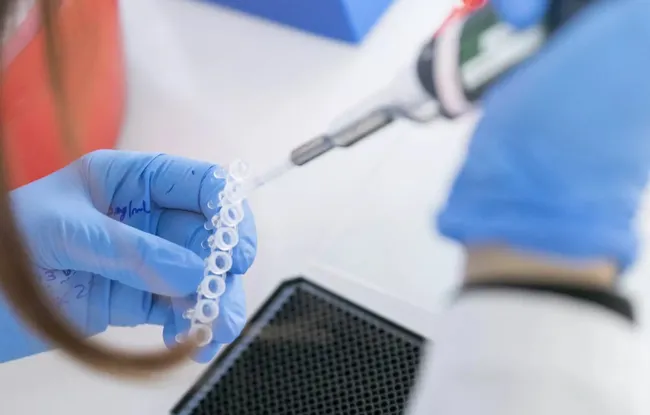- Home >
- Institut Curie News >
- Centromeres, unexpected players in immunity
For the first time, a direct link between centromeres (a specific chromosomal region that plays a key role in cell division) and the immune system has been established by a team from Institut Curie, Inserm and CNRS. The discovery of this new pathway for immune activation opens up new avenues for immunotherapy. This research has just been published in the journal Cell.
In oncology, immunotherapy treatment is based on stimulating the patient's immune system to recognize and destroy tumor cells . Immunotherapy has been growing rapidly for the past 30 years, and the challenge for researchers today is to identify more mechanisms involved in triggering an immune response in order to develop new therapeutic targets.
First link established between centromeres and immunity
This study, conducted at Institut Curie by Drs. Nicolas Manel (Inserm) and Xavier Lahaye (CNRS) in the unit Immunity and Cancer, , in collaboration with Dr Daniele Fachinetti 's team (CNRS) in the Nuclear Dynamics Unit,1 reveals for the first time a link between centromeres, chromosome structures that enable, among other things, their separation into daughter cells during mitosis, and the immune system. The researchers have shown that the presence of a virus in the nucleus triggers a disruption in centromere stability, which is detected by the cell, thereby activating the immune system to initiate an antiviral response.
“The hope behind this research is that the identification and decoding of viral detection systems will lead to the development of therapies capable of exploiting these mechanisms. This publication marks a first step, and we hope to see the development of molecules targeting this pathway in the near future, to be tested in clinical trials within a few years,” concludes Nicolas Manel.

Viral infection induces centromere instability, which is detected by the cell and leads to activation of the immune system.
Using viruses to explore the immune system
Viruses are interesting tools for studying the functioning of the immune system, as they are easy to manipulate in the laboratory and have powerful biological effects. Their intrinsic properties—their ability to infect, hijack cellular functions, and trigger strong immune responses—make them valuable tools for research. This is why Nicolas Manel's team uses them in their laboratory.
“The mechanisms for detecting viruses in the cell cytoplasm are well understood today. But when they are found in the nucleus, we do not clearly understand how their presence is detected by the immune system. Understanding and dissecting these mechanisms could, among other things, enable us to propose new targets for immunotherapy,” explains Nicolas Manel.
[1] Within the Immunity and Cancer Unit (Institut Curie, Inserm), Nicolas Manel is a research director at Inserm and head of the Innate Immunity team at Institut Curie, while Xavier Lahaye is a research fellow at the CNRS in the same team. Daniele Fachinetti is Director of Research at the CNRS and Head of the Molecular Mechanisms of Chromosome Dynamics team at Institut Curie within the Nuclear Dynamics Unit (Institut Curie, CNRS, Sorbonne Université).
Source
Reference: Xavier Lahaye, Patrick Tran Van, Camellia Chakraborty, Anna Shmakova, Ngoc Tran Bich Cao, Hermine Ferran, Ouardia Ait-Mohamed, Mathieu Maurin, Joshua J Waterfall, Benedikt B. Kaufer, Patrick Fischer, Thomas Hennig, Lars Dölken, Patrick Lomonte, Daniele Fachinetti, Nicolas Manel. Cell, June 2, 2025. https://doi.org/10.1016/j.cell.2025.05.008
Research News
Discover all our news
Celebration
The Immunity and Cancer research unit (U932) celebrates its twentieth anniversary
12/12/2025
Artificial Intelligence
08/12/2025


